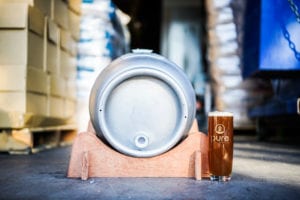What is a Real Ale anyway?
What is a Real Ale anyway?
Posted by Chris Leguizamon
4 years ago | February 26, 2021
Estimated Reading Time: 1 minute, 52 seconds
Have you ever tried cask beer or bottle conditioned beer? If so, then you’ve likely had “real ale”. But what makes these types of beers more “real” than all other types of beer anyway?
“Real ale” is a name coined by the Campaign for Real Ale (CAMRA) (more on that below) and defined by the Oxford English Dictionary as “beer brewed from traditional ingredients, matured by secondary fermentation in the container from which it is dispensed, and served without the use of extraneous carbon dioxide.”
The fundamental difference between real and other ales is the presence of live yeast in the container from which the real ale is served (though it will likely have settled to the bottom and is usually not poured into the glass). Because the yeast is still alive, it continues to feed on any fermentable sugars in the cask or bottle on the way to the consumer, imparting its own unique aromas and flavors as well as life-enhancing carbonation.
 When it comes to cask beer, the end result is an unfiltered beer slightly cloudy in appearance, with a gentle level of carbonation, a round mouthfeel, and a complex profile with elegant esters from cask-conditioning. It’s best served at cellar temperature (around 55°F).
When it comes to cask beer, the end result is an unfiltered beer slightly cloudy in appearance, with a gentle level of carbonation, a round mouthfeel, and a complex profile with elegant esters from cask-conditioning. It’s best served at cellar temperature (around 55°F).
Many traditional pubs in the U.K. serve a variety of cask beers alongside draft, bottle, and can offerings. But there was a time when cask beers were in danger of going the way of the dodo. Rewinding back to 1970s England, many large-scale breweries bought out small-scale breweries, and a reduction in consumer choice was the norm. Because serving cask beer is a significantly time- and labor-intensive process, it was considered by some to be too much of a bother. Instead, the national breweries began to produce and promote a range of heavily filtered, artificially carbonated, light ales and lagers that were served on draft–a much more efficient process–thanks to developments in industrialization.
This is where the Campaign for Real Ale (CAMRA) comes in. CAMRA is a U.K.-based consumer organization, formed by real ale enthusiasts in 1971, that campaigns for the promotion of cask-conditioned real ale. Thanks to the revival of interest in more flavorful beers sparked by CAMRA, cask-conditioned real ale continues to be served today–both in England and around the world. (You’ll recognize a cask beer by the 10.8-gallon metal cask, or firkin, that it’s stored in.) Though not as common as it used to be, cask ale is still considered by many to be “draft beer at its best.”





